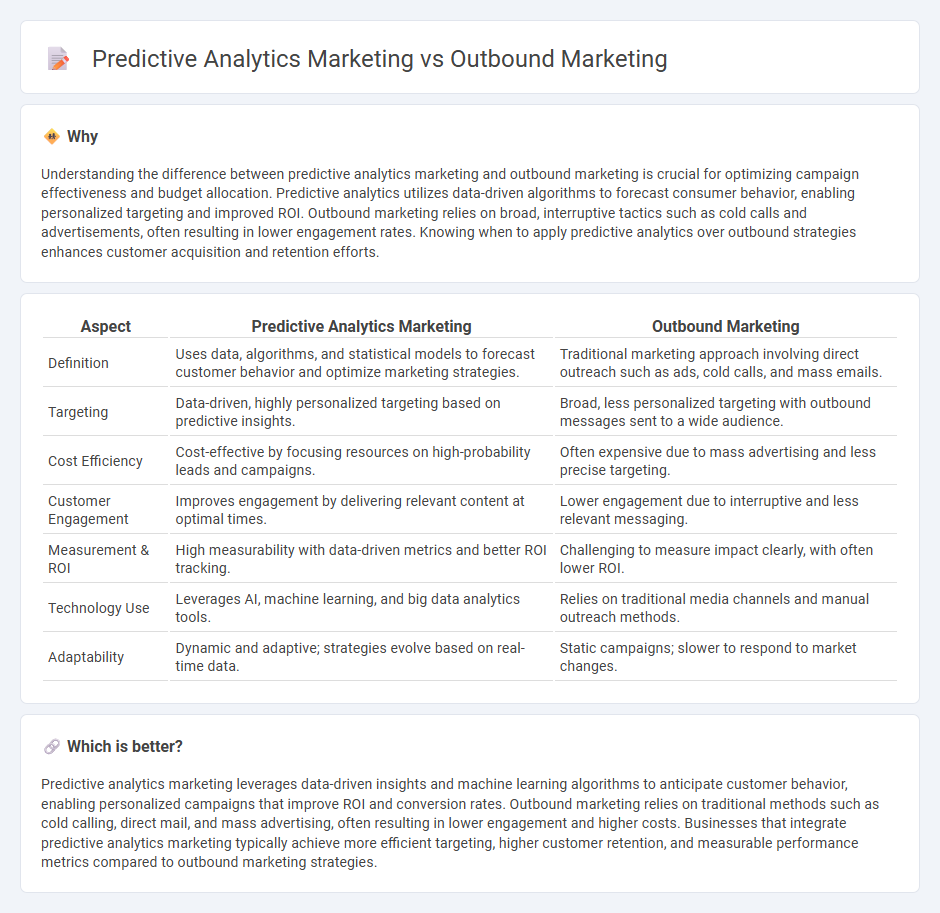
Predictive analytics marketing uses data-driven insights and machine learning models to anticipate customer behavior and tailor campaigns for higher ROI, while outbound marketing relies on broad, traditional methods like cold calls and advertisements to reach a wide audience. By leveraging predictive analytics, businesses can target specific customer segments more effectively, reducing costs and improving conversion rates compared to outbound strategies. Discover how predictive analytics transforms marketing strategies by enhancing precision and efficiency.
Why it is important
Understanding the difference between predictive analytics marketing and outbound marketing is crucial for optimizing campaign effectiveness and budget allocation. Predictive analytics utilizes data-driven algorithms to forecast consumer behavior, enabling personalized targeting and improved ROI. Outbound marketing relies on broad, interruptive tactics such as cold calls and advertisements, often resulting in lower engagement rates. Knowing when to apply predictive analytics over outbound strategies enhances customer acquisition and retention efforts.
Comparison Table
| Aspect | Predictive Analytics Marketing | Outbound Marketing |
|---|---|---|
| Definition | Uses data, algorithms, and statistical models to forecast customer behavior and optimize marketing strategies. | Traditional marketing approach involving direct outreach such as ads, cold calls, and mass emails. |
| Targeting | Data-driven, highly personalized targeting based on predictive insights. | Broad, less personalized targeting with outbound messages sent to a wide audience. |
| Cost Efficiency | Cost-effective by focusing resources on high-probability leads and campaigns. | Often expensive due to mass advertising and less precise targeting. |
| Customer Engagement | Improves engagement by delivering relevant content at optimal times. | Lower engagement due to interruptive and less relevant messaging. |
| Measurement & ROI | High measurability with data-driven metrics and better ROI tracking. | Challenging to measure impact clearly, with often lower ROI. |
| Technology Use | Leverages AI, machine learning, and big data analytics tools. | Relies on traditional media channels and manual outreach methods. |
| Adaptability | Dynamic and adaptive; strategies evolve based on real-time data. | Static campaigns; slower to respond to market changes. |
Which is better?
Predictive analytics marketing leverages data-driven insights and machine learning algorithms to anticipate customer behavior, enabling personalized campaigns that improve ROI and conversion rates. Outbound marketing relies on traditional methods such as cold calling, direct mail, and mass advertising, often resulting in lower engagement and higher costs. Businesses that integrate predictive analytics marketing typically achieve more efficient targeting, higher customer retention, and measurable performance metrics compared to outbound marketing strategies.
Connection
Predictive analytics in marketing leverages data to forecast customer behavior and optimize outbound marketing campaigns by targeting the right audience with personalized messaging. Integrating predictive models enhances the efficiency of outbound channels such as email, direct mail, and telemarketing by prioritizing high-potential leads. This connection significantly improves conversion rates and reduces customer acquisition costs.
Key Terms
Lead Generation
Outbound marketing employs traditional techniques such as cold calling, email blasts, and direct mail to generate leads by reaching out to a broad audience, often resulting in lower conversion rates due to less targeted efforts. Predictive analytics marketing leverages data mining, machine learning algorithms, and historical customer behavior to identify high-potential leads, enabling personalized campaigns that significantly enhance lead quality and conversion rates. Explore how integrating predictive analytics can revolutionize your lead generation strategy and drive measurable business growth.
Data Modeling
Outbound marketing relies heavily on traditional data modeling techniques to segment target audiences and predict customer responses based on historical interactions. Predictive analytics marketing uses advanced machine learning algorithms and real-time data to create dynamic models that forecast consumer behavior with higher accuracy. Explore how integrating sophisticated data modeling enhances marketing strategies and drives business growth.
Audience Segmentation
Outbound marketing relies on broad audience segmentation through demographic and geographic criteria to target potential customers via traditional channels like TV, radio, and cold calling. Predictive analytics marketing uses machine learning algorithms and historical data to create precise, dynamic audience segments based on behavior patterns, intent signals, and purchase probabilities. Explore how combining both strategies can enhance your marketing effectiveness.
Source and External Links
Outbound Marketing Examples To Grow Brand Awareness & Pipeline - Outbound marketing is a proactive strategy to reach potential customers before they show interest, using tactics like cold emails, TV ads, and billboards to build brand awareness and drive sales by initiating contact with the audience.
A Guide to Outbound Marketing Strategies | Salesforce US - Outbound marketing involves starting conversations with potential customers through traditional push methods such as print ads, cold calls, and direct mail to grow awareness and initiate relationships, often complementing inbound marketing efforts.
What Is Outbound Marketing? - WordStream - Outbound marketing means a company initiates contact with an audience via TV commercials, radio ads, cold calls, and printed ads, contrasting with inbound methods where customers come to the company, though it is often harder to track and may be less profitable.
 dowidth.com
dowidth.com